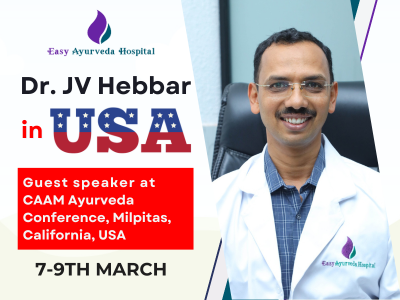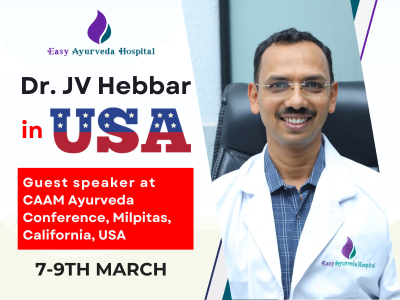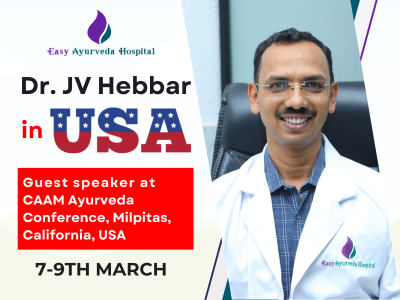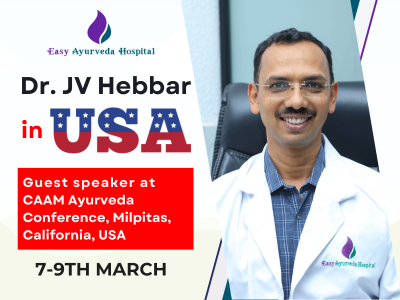The 22nd chapter of Cikitsasthanam of Ashtanga Hridayam is named as Vata Vyadhi Cikitsitam Adhyayah. This chapter deals with the explanation of ‘treatment of gout’.
The topics covered in this chapter include –
- Raktamokshana – bloodletting
- Snigdha Virecana
- Vataja Vatarakta Cikitsa
- Pittaja Vatarakta Cikitsa
- Kaphaja Vatarakta Cikitsa
- Bahya Cikitsa – external treatments
- Pinda Taila
- Dasamula Ksheera Parisheka
- Chaturvidha Sneha Parisheka
- Madhuyastyadi Taila
- Sahasrapaka Bala Taila
- Treatment principles for vata being obstructed by increased kapha and meda
- Avarana Vata Cikitsa
- Pittavrta Vata Cikitsa
- Kaphavrta Vata Cikitsa
- Kapha-pittavrta Vata Cikitsa
- Dhatu Avrta Vata Cikitsa
- Sarva Avrta Vata Cikitsa
- Summary of avarana
- Treatment principles for vata subtypes
- Indications of Lashuna in Avarana
- Treatment for vata avarana caused by pitta and rakta
Pledge by the author (s)
अथातो वातशोणितचिकित्सं व्याख्यास्याम:
व्याख्यास्याम: ।
इति ह स्माहुरात्रेयादयो महर्षय: ।
After having offered prayers to the God, henceforth we are going to explain the chapter pertaining to the explanation of ‘treatment of gout’. Thus say (pledge) Atreya and other sages.
Raktamokshana: Bloodletting
वातशोणितिनो रक्तं स्निग्धस्य बहुशो हरेत् ।
अल्पाल्पं पालयन् वायुं यथादोषं यथाबलम् ॥ १ ॥
The blood of the patient of Vatasonita (gout) should be let out, in small quantities, at many times after giving him oleation therapy, protecting him from (aggravation of) Vata; bloodletting being appropriate to the Dosha and strength (of the body).
रुग्रागतोददाहेषु जलौकोभिर्विनिर्हरेत् ।
शृङ्गतुम्बैश्चिमिचिमाकण्डूरुग्दूयनान्वितम् ॥ २ ॥
प्रच्छानेन सिराभिर्वा देशाद्देशान्तरं व्रजत् ।
When pain, redness, pricking painand burning sensation are present, blood should be sucked by leeches. When tingling sensation, itching, pain and burning sensation are present, by using the (sucking horn or ground), when the disease / lesion is found spreading from place to place, by either scratching the skin or venesection.
अङ्गग्लानौ तु न स्राव्यं रूक्षे वातोत्तरे च यत् ॥ ३ ॥ गम्भीरं श्वयथुं स्तम्भं कम्पं स्नायुसिरामयान् ।
ग्लानिमन्यांश्च वातोत्थान् कुर्याद्वायुरसृक्क्षयात् ॥ ४ ॥
Blood should not be let out when there is debility of the body, dryness and predominance of Vata. Vata getting aggravated by loss of blood (from Blood- letting) produces profound swelling, stiffness, tremors, diseases of tendons, and Veins, debility and many other disorders of Vata origin.
Snigdha Virechana
विरेच्यः स्नेहयित्वा तु स्नेहयुक्तैर्विरेचनैः ।
He who is suitable for purgation therapy should be given oleation therapy first and then administered purgative herbs mixed with fats (medicated Ghee/ oil)
Vataja Vatarakta Chikitsa
वातोत्तरे वातरक्ते पुराणं पाययेद्घृतम् ॥ ५ ॥
In Vatarakta (gout) having predominance of Vata, the patient should be made to drink old ghee.
श्रावणीक्षीरकाकोलीक्षीरिणीजीवकैः समैः ।
सिद्धं सर्षभकैः सर्पिः सक्षीरं वातरक्तनुत् ॥ ६ ॥
Medicated ghee prepared with the decoction of equal quantity of each of śrāvaṇī – Sphaeranthus indicus, kṣīrakākolī – Lilium polyphyllum, kṣīriṇī – Hemidesmus indicus, jīvakaiḥ – Malaxis acuminata, ṛṣabhakaiḥ – and Manilkara hexandra, mixed with milk, equal in quantity of the decoction cures Vatarakta.
द्राक्षामधूकवारिभ्यां सिद्धं वा ससितोपलम् ।
घृतं पिबेत्तथा क्षीरं गुडूचीस्वरसे शृतम् ॥ ७ ॥
तैलं पयः शर्करां च पाययेद्वा सुमूर्छितम् ।
बलाशतावरीरास्नादशमूलैः सपीलुभिः ॥ ८ ॥
श्यामैरण्डस्थिराभिश्च वातार्तिघ्नं शृतं पयः ।
धारोष्णं मूत्रयुक्तं वा क्षीरं दोषानुलोमनम् ॥ ९ ॥
Ghrita prepared with decoction of drākṣā – Vitis vinifera and madhūka – Madhuca longifolia, added with sugar candy should be consumed; or milk boiled with addition of fresh juice of guḍūcī – Tinospora cordifolia; or drink the mixture of oil, milk and sugar boiled together. Milk boiled with balā – Sida cordifolia, śatāvarī – Asparagus racemosus, rāsnā – Pluchea lanceolata, daśamūla –
Shalaparni – Desomodiumgangeticum
Prishniparni – Urariapicta
Brihati – Solanum indicum
Kantakari – Solanum xanthocarpum
Gokshura – Tribulus terrestris
Bilva – Aegle Marmelos
Agnimantha – Premna mucronata
Shyonaka – Oroxylum indicum
Patala – Stereospermum suaveolens
Gambhari – Gmelina arborea
pīlu – Salvadora persica, śyāma – Operculina turpethum, eraṇḍa – Ricinus Communis, and sthirā – Desmodium gangeticum cures pain produced by Vata. Milk warm from the udder, added with cow urine causes downward movement of Vata.
Pittaja Vatarakta Chikitsa
पैत्ते पक्त्वा वरीतिक्तापटोलत्रिफलामृताः ।
पिबेद्घृतं वा क्षीरं वा स्वादुतिक्तकसाधितम् ॥ १० ॥
In Vatarakta caused by Pitta, decoction of varī – Asparagus racemosus, tiktā – Swertia chirata, paṭola – Trichosanthes dioica, triphala – Triphala (Haritaki – Terminalia chebula, Vibhitaki – Terminalia bellerica, Amalaki – Emblica officinalis) and amṛtāḥ – Tinospora cordifolia should be consumed; or ghee or milk boiled with herbs of sweet and bitter tastes (should be consumed).
क्षीरेणैरण्डतैलं च प्रयोगेण पिबेन्नरः ।
बहुदोषो विरेकार्थं जीर्णे क्षीरौदनाशनः ॥ ११ ॥
eraṇḍatailaṃ – Oil of Ricinus communis mixed with milk is administered, should be consumed, to produce purgation in the patient who has great increase of Dosha; After it gets digested (and after purgation) he should eat boiled rice along with milk.
कषायमभयानां वा पाययेद्घृतभर्जितम् ।
क्षीरानुपानं त्रिवृताचूर्णं द्राक्षारसेन वा ॥ १२ ॥
Decoction of abhayā – Terminalia chebula fried in ghee should be consumed followed by drinking of milk; or drink powder of Operculina turpethum mixed with juice of drākṣā – Vitis vinifera
निर्हरेद्वा मलं तस्य सघृतैः क्षीरवस्तिभिः ।
न हि बस्तिसमं किञ्चिद्वातरक्तचिकित्सितम् ॥ १३ ॥
विशेषात् पायुपार्श्वोरुपर्वास्थिजठरार्तिषु ।
The Malas (Doshas) may also be removed by Ksirabasti (milk enema) added with ghee. There is nothing equal to basti (enema therapy) in the treatment of Vatarakta (gout), especially for those who have pain in the rectum, flanks, thighs joints, bones and abdomen.
Kaphaja Vatarakta Chikitsa
मुस्ताधात्रीहरिद्राणां पिबेत्क्वाथं कफोल्बणे ॥ १४ ॥ सक्षौद्रं त्रिफलाया वा गुडूचीं वा यथा तथा ।
यथार्हस्नेहपीतं च वामितं मृदु रूक्षयेत् ॥ १५ ॥
When Kapha is predominant, the decoction of mustā – Cyperus rotundus, dhātrī – Emblica officinalis and haridrā – Curcuma longa should be consumed triphalāyā vā – or of Triphala (Haritaki – Terminalia chebula, Vibhitaki – Terminalia bellerica, Amalaki – Emblica officinalis) guḍūcīṃ vā – Tinospora cordifolia, whichever is suitable, should be consumed mixed with honey. After administering the appropriate Sneha (fat) to drink, he should be given mild emetic herbs and then Ruksana is given (therapy creating dryness inside).
त्रिफलाव्योषपत्रैलात्वक्क्षीरीचित्रकं वचाम् ।
विडङ्गं पिप्पलीमूलं रोमशां वृषकं त्वचम् ॥ १६ ॥
ऋद्धिं लाङ्गलिकीं चव्यं समभागानि पेषयेत् ।
कल्ये लिप्त्वाऽऽयसीं पात्रीं मध्याह्ने भक्षयेदिदम् ॥ १७ ॥
वातास्रे सर्वदोषेऽपि परं शूलान्विते हितम् ।
vyoṣa – Vyosa (Black pepper – Piper nigrum, Long pepper fruit – Piper longum and Ginger – Zingiber officinale), patra – Cinnamomum tamala, elā – Elettaria cardamomum, tvak kṣīrī – Bambusa arundinacea, citrakaṃ – Plumbago zeylanica, vacām – Acorus calamus, viḍaṅgaṃ – Embelia ribes, pippalīmūlaṃ – root of Piper longum, romaśāṃ – ferrous sulphate, vṛṣakaṃ – Adhathoda vasica, tvacam – Cinnamomum zeylanica, ṛddhiṃ – Habenaria intermedia, lāṅgalikīṃ – Gloriosa superba and cavyaṃ – Piper retrofractum each equal in quantity is made into a paste (with water). In the next morning it is smeared to an iron vessel and (taken out and) consumed in the midday. This is best suited in gout even caused by all the Doshas and accompanied with pain.
कोकिलाक्षकनिर्यूहः पीतस्तच्छाकभोजिना ॥ १८ ॥
कृपाभ्यास इव क्रोधं वातरक्तं नियच्छति ।
Decoction of kokilākṣaka – Asteracantha longifolia consumed followed by Partaking leafy vegetables only as food, cures gout just like the practice of compassion cures anger.
पञ्चमूलस्य धात्र्या वा रसैर्लेलीतकीं वसाम् ॥ १९ ॥
खुडं सुरूढमप्यङ्गे ब्रह्मचारी पिबन् जयेत् ।
इत्याभ्यन्तरमुद्दिष्टं कर्म बाह्यमतः परम् ॥ २० ॥
pañcamūlasya dhātryā vā rasairlelītakīṃ vasām || 19
Sulphur muscle fat consumed along with the juice (decoction) of Pancamula dhātryā vā – Or Emblica officinalis by the patient adhering to celibacy (avoiding sexual intercourse) consumed cures Vatarakta (gout) though deep rooted in the body. Thus-far were described, the internal treatment, further, the external treatments.
Bahya Chikitsa: External treatments
आरनालाढके तैलं पादसर्जरसं शृतम् ।
प्रभूते खजितं तोये ज्वरदाहार्तिनुत्परम् ॥ २१ ॥
Taila (oil) boiled in one adhaka (3 litre 72 ml) of sour rice wash pāda added with sarjarasaṃ – Vateria indica, one fourth of the quantity (of oil) and well churned mixed with more of water, is best to cure fever, burning sensation and pain.
Pinda Taila
समधूच्छिष्टमञ्जिष्ठं ससर्जरसशारिवम् ।
पिण्डतैलं तदभ्यङ्गाद्वातरक्तरुजापहम् ॥ २२ ॥
Medicated oil prepared with bee’s vax, mañjiṣṭhaṃ – Rubia cordifolia, sarjarasa – Vateria indica and śārivam – Hemidesmus indicus Known as Pinda taila used for Abhyanga (anointing and Massage) relieves the pain of Vataraka (Gout).
Dashamula Ksheera Parisheka
दशमूलशृतं क्षीरं सद्यः शूलनिवारणम् ।
परिषेकोऽनिलप्राये तद्वत् कोष्णेन सर्पिषा ॥ २३ ॥
Milk boiled with herbs of Dasamula –
Bilva – Aegle Marmelos
Agnimantha – Premna mucronata
Shyonaka – Oroxylum indicum
Patala – Stereospermum suaveolens
Gambhari – Gmelina arborea
Shalaparni – Desomodium gangeticum
Prishniparni – Uraria picta
Brihati – Solanum indicum
Kantakari – Solanum xanthocarpum
Gokshura – Tribulus terrestris
poured warm over the body relieves the pain quickly when, Anila (vata) is Predominant; similarly, so when warm ghee is poured.
Chaturvidha Sneha Parisheka
स्नेहैर्मधुरसिद्धैर्वा चतुर्भिः परिषेचयेत् ।
स्तम्भाक्षेपकशूलार्तं कोष्णैर्दाहे तु शीतलैः ॥ २४ ॥
(The mixture of) The four fats (ghee oil, muscle fat and marrow) processed with herbs of sweet taste, should be poured warm over the body of those who have rigidity, convulsions and pain; and poured cold when there is burning sensation.
तद्वद्गव्याविकच्छागैः क्षीरैस्तैलविमिश्रितैः ।
निःक्वाथैर्जीवनीयानां पञ्चमूलस्य वा लघोः ॥ २५ ॥
Similarly, the milk of cow, sheepor goat mixed with oil (should be poured on the body) or the decoction ofherbs of either Jivaniya Gana (chapter 15 of Sutrasthana) or of Laghu Pancamula.
द्राक्षेक्षुरसमद्यानि दधिमस्त्वम्लकाञ्जिकम् ।
सेकार्थं तण्डुलक्षौद्रशर्कराम्भश्च शस्यते ॥ २६ ॥
drākṣekṣurasamadyāni dadhimastvamlakāñjikam |
sekārthaṃ taṇḍulakṣaudraśarkarāmbhaśca śasyate || 26 ||
Juice of Vitis vinifera, and ikṣurasa – Saccharum officinarum, wines, watery portion of curds, fermented gruel rice-wash honey water or sugar-water are suitable for pouring over the body.
प्रियाः प्रियंवदाः नार्याश्चन्दनार्द्रकरस्तनाः ।
स्पर्शशीताः सुखस्पर्शा घ्नन्ति दाहं रुजं क्लमम् ॥ २७ ॥
The women who are liked, who speak pleasant, who have moistened their hands, and breasts by anointing the paste of candana – Santalum album, thereby cold touch, relieve burning sensation, pain and exhaustion by their comforting touch (embrace).
सरागे सरुजे दाहे रक्तं हृत्वा प्रलेपयेत् ।
प्रपौण्डरीकमञ्जिष्ठादार्वीमधुकचन्दनैः ॥ २८ ॥
सितोपलैरकासक्तुमसूरोशीरपद्मकैः ।
लेपो रुग्दाहवीसर्परागशोफनिबर्हणः ॥ २९ ॥
When there is redness, pain and burning sensation, the blood should be let out first and the paste of prapauṇḍarīka – Nymphaea lotus, mañjiṣṭhā – Rubia cordifolia, dārvī – Berberis aristata, madhuka – Glycyrrhiza glabra, candana – Santalum album applied on the body; paste of sugacandy, saktu – roasted flour of erakā – Typha elephantina, masūra – Lens culinaris, uśīra – Vetiveria zizoanioides and padmaka – Prunus cerasoides cures pain, burning sensation, herpes, redness, and swelling.
वातघ्नैः साधितः स्निग्धः कृशरो मुद्गपायसः ।
तिलसर्षपपिण्डैश्च शूलघ्नमुपनाहनम् ॥ ३० ॥
Rice boiled along with green gram or milk pudding processed with herbs with mitigate Vata and added with fats; or boluses prepared from tila – Sesamum indicum, or sarṣapa – Brassica juncea are pain killing warm poultice.
औदकप्रसहानूपवेसवाराः सुसंस्कृताः ।
जीवनीयौषधैः स्नेहयुक्ताः स्युर्उपनाहने ॥ ३१ ॥
स्तम्भतोदरुगायामशोफाङ्गग्रहनाशनाः ।
जीवनीयौषधैः सिद्धा सपयस्का वसाऽपि वा ॥ ३२ ॥ Spiced meat prepared frommeat of animals living water or Prasaha group or of Marshy lands (chapterof Sutrathana) processed well with herbs of Jivaniya Gana (Chapter 15 of Sutrasthana) added with fats (oil) are useful as warm poultice. Muscle fat of the above kinds of animals processed with herbs of Jivaniya Gana and added with milk (and applied as warm poultice) relieves rigidity, pricking pain, constant pain, dilation, swelling and catching pain of the body will be cured.
घृतं सहचरान् मूलं जीवन्ती छागलं पयः ।
लेपः पिष्टास्तिलास्तद्वद्भृष्टाः पयसि निर्वृताः ॥ ३३ ॥ Ghee boiled with sahacarānmūlaṃ – roots of Strobilanthusciliatus and jīvantī – Leptadenia reticulate mixed with Goats milk is a Good Poultice; so also paste of fried tilā: – Sesamum indicum, made with milk provides relief.
क्षीरपिष्टक्षुमां लेपमेरण्डस्य फलानि वा ।
कुर्याच्छूलनिवृत्त्यर्थं शताह्वां वाऽनिलेऽधिके ॥ ३४ ॥
Application of paste of kṣumāṃ – Linumus titissimum or of the seeds of eraṇḍ – Ricinus communis or of śatāhva – Anethum sowa macerated with milk, cures pain when Vata is greatly increased.
मूत्रक्षारसुरापक्वं घृतमभ्यञ्जने हितम् ।
सिद्धं समधु शुक्तं वा सेकाभ्यङ्गे कफोत्तरे ॥ ३५ ॥
Ghee boiled with addition of cow urine, Yavaksara, and beer is good for oil massage and bath or sukta (sour gruel) mixed with honey is good for pouring on the body and anointing when kapha is predominant.
गृहधूमो वचा कुष्ठं शताह्वा रजनीद्वयम् ।
प्रलेपः शूलनुद्वातरक्ते वातकफोत्तरे ॥ ३६ ॥
मधुशिग्रोर्हितं तद्वद्बीजं धान्याम्लसंयुतम् ।
मुहूर्तलिप्तमम्लैश्च सिञ्चेद्वातकफोत्तरे ॥ ३७ ॥
Application of paste of soot of chimney, vacā – Acorus calamus, kuṣṭhaṃ – Saussurea lappa, śatāhvā – Anethum sowa rajanī dvayam – and the two Rajani (Haridra – Curcuma longa, Daruharidra – Berberis aristata) relieves the pain in gout having predominance of Vata and Kapha. Similarly, madhuśigro: bījaṃ – the paste of seeds of Moringa oleifera, macerated with Dhanyamla (fermented liquid prepared with grains) is beneficial (in gout having predominance of Vata Kapha). This paste should be allowed to remain for 48 minutes and then sprinkled with sour liquids when Vata and Kapha are predominant.
उत्तानं लेपनाभ्यङ्गपरिषेकावगाहनैः ।
विरेकास्थापनस्नेहपानैर्गम्भीरमाचरेत् ॥ ३८ ॥
The Uttana Kind (superficial) of Vatarakta should be treated with application of pastes, anointing with fats, pouring liquids, and immersing the body in liquids and in Gambhira kind – deep seated, administer purgation, decoction enema and drinking of fats.
वातश्लेष्मोत्तरे कोष्णा लेपाद्यास्तत्र शीतलैः ।
विदाहशोफरुक्कण्डूविवृद्धिः स्तम्भनाद्भवेत् ॥ ३९ ॥
When Vata and Kapha are predominant, warm application of paste etc. are beneficial; if cold applications are made, burning sensation, swelling, pain and itching will increase due to rigidity (caused by cold).
पित्तरक्तोत्तरे वातरक्ते लेपादयो हिमाः ।
उष्णैः प्लोषोषरुग्रागस्वेदावदरणोद्भवः ॥ ४० ॥
In gout, when there is predominance of Pitta and Rakta cold application are beneficial, blisters, blebs, localised burning sensation, pain, redness, sweating, and laceration, abrasion will develop by heat (of warm application).
Madhuyastyadi Taila
मधुयष्ट्याः पलशतं कषाये पादशेषिते ।
तैलाढकं समक्षीरं पचेत्कल्कैः पलोन्मितैः ॥ ४१ ॥
स्थिरातामलकीदूर्वापयस्याभीरुचन्दनैः ।
लोहहंसपदीमांसीद्विमेदामधुपर्णिभिः ॥ ४२ ॥
काकोलीक्षीरकाकोलीशतपुष्पर्द्धिपद्मकैः ।
जीवकर्षभजीवन्तीत्वक्पत्त्रनखवालकैः ॥ ४३ ॥
प्रपौण्डरीकमञ्जिष्ठाशारिवैन्द्रीवितुन्नकैः ।
चतुष्प्रयोगं वातासृक्पित्तदाहज्वरार्तिनुत् ॥ ४४ ॥
One hundred Pala (4.8 Kg) of madhuyaṣṭyāḥ – Glycyrrhiza glabra is boiled in one drona (12 litre 228ml) of water and decoction reduced to one-fourth the quantity. To this are added, one adhaka (3 litres 72 ml) of oil, equal (same) quantity of milk and paste of one Pala (48 grams) each of sthirā – Desmodium gangeticum, tāmalakī – Phyllanthus niruri, dūrvā – Cynodon dactylon, payasyā – Calotropis gigantea, bhīru – Asparagus racemosus, candana – Santalum album, loha – aguru – Aquilaria agallocha, haṃsapadī – Adiantum lunulatum, māṃsī – Nardostachys jatamansi, dvi medā – the two Meda (Meda – Polygonatum cirrhifolium, Mahameda – Polygonatum verticillatum), madhuparṇibhiḥ – Madhuparni Tinospora cordifolia, kākolī – Fritillaria roylei, kṣīrakākolī – Roscoea purpurea, śatapuṣpa – Anethum sowa, ṛrddhi – Habenaria intermedia, padmakaiḥ – Prunus cerasoides, jīvaka – Malaxis acuminata, ṛṣabha – Manilkara hexandra, jīvantī – Leptadenia reticulata, tvak – Cinnamomum zeylanicum, patra – Cinnamomum tamala, nakha – Capparis sepiaria, vālaka – Coleus vettiveroides, prapauṇḍarīka – Nymphaea lotus, mañjiṣṭhā – Rubia cordifolia, śāriva – Hemidesmus indicus, endrī – Citrullus colocynthis and medicated oil cooked. This oil used in the four ways (drinking, nasal medication, oil- enema and decoction- enema) gout, diseases of Pitta origin, burning sensation and fever will be cured.
Sahasrapaka Bala Taila / Ksheerabala Taila
बलाकषायकल्काभ्यां तैलं क्षीरसमं पचेत् ।
सहस्रशतपाकं तद्वातासृग्वातरोगनुत् ॥ ४५ ॥
रसायनं मुख्यतममिन्द्रियाणां प्रसादनम् ।
जीवनं बृंहणं स्वर्यं शुक्रासृग्दोषनाशनम् ॥ ४६ ॥
Decoction and paste of balā – Sida cordifolia, oil and equal quantity of milk are cooked a thousand times, or hundred times and medicated oil prepared. This cures gout and diseases of Vata origin, is a rejuvenator foremost, bestows comfort to the sense organs, enlivens stouten the body, good for the voice, dispels the disorders of semen and blood.
Treatment principles for vata being obstructed by increased kapha and meda
कुपिते मार्गसंरोधान् मेदसो वा कफस्य वा ।
अतिवृद्ध्याऽनिले शस्तं नादौ स्नेहनबृंहणम् ॥ ४७ ॥
कृत्वा तत्राढ्यवातोक्तं वातशोणितिकं ततः ।
भेषजं स्नेहनं कुर्याद्यच्च रक्तप्रसादनम् ॥ ४८ ॥
When Vata gets aggravated due to obstruction of its channels by great increase of either the medas (fat) or Kapha, administration of oleation therapy and stoutening therapy are not suitable in the beginning. The treatments prescribed for Adhyavata (urustambha/ Stiffness of the thigh) should be done first and then the treatments of Vatasonita (gout) such as oleation should be done and also such treatments which purifies the blood.
Avarana Vata Chikitsa
प्राणादिकोपे युगपद्यथोद्दिष्टं यथामयम् ।
यथासन्नं च भैषज्यं विकल्प्यं स्याद्यथाबलम् ॥ ४९ ॥
When Prana and other divisions of vata are aggravated simultaneously the treatment which are enumerated (chapter 13 of Sutrasthana) appropriate to the disease (present now) and which are nearest (to the aggravated Dosha) should be chosen and done, considering the strength (of the patient and the aggravated Dosha).
नीते निरामतां सामे स्वेदलङ्घनपाचनैः ।
रूक्षैश्चालेपसेकाद्यैः कुर्यात् केवलवातनुत् ॥ ५० ॥
When Vata is sama (associated with Ama/ presenting symptoms of Ama) it should be made Nirama (free of Symptoms of Ama) by treatments such as sudation, fasting and other thinning therapies digestive herbs, application of pastes and pouring medicinal liquids which are dry (non-fatty). These therapies should be doneand then the treatments suitable for Vata alone.
शोषाक्षेपणसङ्कोचस्तम्भस्वपनकम्पनम् ।
हनुस्रंसोऽर्दितं खाञ्ज्यं पाङ्गुल्यं खुडवातता ॥ ५१ ॥
सन्धिच्युतिः पक्षवधो मेदोमज्जास्थिगा गदाः ।
एते स्थानस्य गाम्भीर्यात् सिध्येयुर्यत्नतो नवाः ॥ ५२ ॥
तस्माज्जयेन्नवानेतान् बलिनो निरुपद्रवान् ।
Dryness of body parts, tremors, contractures, stiffness, loss of sensation, trembling, dislodgement of jaw, facial paralysis, limp, lame, gout, dislocation of joints, hemiplegia, diseases lodged in fat, bone marrow and bones these diseases being located deeply in the tissues are curable with great efforts when they are freshly manifested. Therefore, they should be won over (cured) when they are new (acute, freshly manifested), when they are manifested in strong people, when they are devoid of complications.
Pittavrita Vata Chikitsa
वायौ पित्तावृते शीतामुष्णां च बहुशः क्रियाम् ॥ ५३ ॥
व्यत्यासाद्योजयेत् सर्पिर्जीवनीयं च पाययेत् ।
धन्वमांसं यवाः शालिर्विरेकः क्षीरवान् मृदुः ॥ ५४ ॥
सक्षीरा वस्तयः क्षीरं पञ्चमूलबलाशृतम् ।
कालेऽनुवासनं तैलैर्मधुरौषधसाधितैः ॥ ५५ ॥
यष्टीमधुबलातैलघृतक्षीरैश्च सेचनम् ।
पञ्चमूलकषायेण वारिणा शीतलेन वा ॥ ५६ ॥
When Vata is enveloped (hindered from movement, obstructed in actions) by Pitta (increased) treatment which is cold and hot should be administered alternately, many times. Jivaniya Ghrta (chapter 24 of Chikitsa Sthana of Astanga Sangraha) should be consumed. Should use meat of animals of desert- like regions, yavāḥ – Hordeum vulgare, śāli: – and Oryza sativa and mild purgative therapy prepared with milk (mixed with milk) should be administered. Decoction enema therapy with decoction of pañcamūla śṛtam –
Basti (Pancamula –
Bilva – Aegle Marmelos
Agnimantha – Premna mucronata
Shyonaka – Oroxylum indicum
Patala – Stereospermum suaveolens
Gambhari – Gmelina arborea
mixed with milk or milk processed with Sida cordifolia, and oil- enema therapy with oil prepared by herbs of sweet taste should be administered at the appropriate time. Pouring liquid with Madhuyasti Taila, bala taila (described earlier), ghee, milk, decoction of herbs of Pancamula or cold water should be done.
Kaphavrita Vata Chikitsa
कफावृते यवान्नानि जाङ्गला मृगपक्षिणः ।
स्वेदास्तीक्ष्णा निरूहाश्च वमनं सविरेचनम् ॥ ५७ ॥
पुराणसर्पिस्तैलं च तिलसर्षपजं हितम् ।
When vata is enveloped by Kapha, yava – Hordeum vulgare, meat of animals and birds of desert-like regions, should be used as food, sudation, strong decoction enema, emesis and purgation, old ghee, oil of tila – Sesamum indicum and sarṣapa – Brassica juncea are suitable.
Kapha Pittavrita Vata Chikitsa
संसृष्टे कफपित्ताभ्यां पित्तमादौ विनिर्जयेत् ॥ ५८ ॥
When enveloped with both Kapha and Pitta, pitta should be won over (mitigated)
आदौ – ādau – first.
Dhatu Avrita Vata Chikitsa
कारयेद्रक्तसंसृष्टे वातशोणितिकीं क्रियाम् ।
स्वेदाभ्यङ्गरसाः क्षीरं स्नेहो मांसावृते हितम् ॥ ५९ ॥ प्रमेहमेदोवातघ्नमाढ्यवाते भिषग्जितम् ।
महास्नेहोऽस्थिमज्जस्थे पूर्वोक्तं रेतसावृते ॥ ६० ॥
अन्नावृते पाचनीयं वमनं दीपनं लघु ।
मूत्रावृते मूत्रलानि स्वेदाश्चोत्तरवस्तयः ॥ ६१ ॥
एरण्डतैलं वर्चःस्थे वस्तिस्नेहाश्च भेदिनः ।
When enveloped by Rakta (blood), treatments prescribed for Vatasonita (gout) should be done. When enveloped by mamsa (muscle tissue), sudation, oil massage, ingestion of meat soup, milk as food, oleation therapy are beneficial. In adhyavata/ stiffness of the thighs) physicians should cure by adopting treatments which are prescribed for diabetes, obesity and Vata are best suited. When enveloped by Asthi and Majja (bone and bone-marrow) administration of Mahasneha (mixture of our fats) and when enveloped by Retas (semen) the treatment stated previously (verse 20-21 of previous chapter) should be done. When enveloped by Anna (food) administration of digestives, emesis, carminative and herbs foods which are easily digestable are ideal. When enveloped by Mutra (urine), diuretics, sudation and uttara vasti (enema given through urinary passages) are ideal. When enveloped by feces, Castor oil, enema and fats (medicated oil or ghee) which produce purgation (breaks the feces) are useful.
Sarva Avrita Vata Chikitsa
कफपित्ताविरुद्धं यद्यच्च वातानुलोमनम् ॥ ६२ ॥
सर्वस्थानावृतेऽप्याशु तत्कार्यं मातरिश्वनि ।
अनभिष्यन्दि च स्निग्धं स्रोतसां शुद्धिकारणम् ॥ ६३ ॥
यापना वस्तयः प्रायो मधुराः सानुवासनाः ।
प्रसमीक्ष्य बलाधिक्यं मृदु कार्यं विरेचनम् ॥ ६४ ॥ रसायनानां सर्वेषामुपयोगः प्रशस्यते ।
शिलाह्वस्य विशेषेण पयसा शुद्धगुग्गुलोः ॥ ६५ ॥
लेहो वा भार्गवस्तद्वदेकादशसिताशितः ।
When Matarisvan (Vata) is enveloped in all the palces (of the body by all the tissues) the treatments which are not opposed to Kapha and Pitta and which make Vata move downward should be done immediately. Foods and herbs which are anabhisyandi (not producing more moisture inside the body tissues and channels), unctuous, which purifies (clears) the channels, Yapana Basti (enema therapy of that name-Vide chapter 4 of Kalpasidhi sthana), oil-enema, prepared from herbs having sweet taste, mild purgation should be administered after considering the good strength of the person. Use of rejuvenator/ tonics always is highly desirable, especially of asphaltum śuddha gugguloḥ – or Commiphora mukul along with milk; or Bhargava Leha (Cyavanaprasa Avaleha chapter 39 of Uttarasthana), similarly of that called Ekadasasasita (Brahmarasayana – chapter 39 of Uttarasthana).
Dhatu Avrita Vata Chikitsa
अपाने त्वावृते सर्वं दीपनं ग्राहि भेषजम् ॥ ६६ ॥
वातानुलोमनं कार्यं मूत्राशयविशोधनम् ।
When Apana Vata is enveloped (by any other division of Vata, any other Dosha, Dhatu, Mala etc.) medicines which are carminative, water absorbent, which make the Vata move in downward direction and which purify the urinary bladder (diuretics) should be administered.
Summary of Avarana
इति सङ्क्षेपतः प्रोक्तमावृतानां चिकित्सितम् ॥ ६७ ॥
प्राणादीनां भिषक् कुर्याद्वितर्क्य स्वयमेव तत् ।
Thus were described in brief the treatments of envelopment of Prana and other divisions of vata; the physician should select the appropriate oneby himself by his intelligent discretion.
Treatment principles for Vata subtypes
उदानं योजयेदूर्ध्वमपानं चानुलोमयेत् ॥ ६८ ॥
समानं शमयेद्विद्वांस्त्रिधा व्यानं तु योजयेत् ।
प्राणो रक्ष्यश्चतुर्भ्योऽपि तत्स्थितौ देहसंस्थितिः ॥ ६९ ॥
स्वं स्वं स्थानं नयेदेवं वृतान् वातान् विमार्गगान् ।
Udana Vata should be raised (made to act in the upward direction), and apana Vata should be lowered (made to act in the downward direction), Samana vata should be given Samana (palliative therapy) to mitigate itby the intelligent Physicia. Vyana vata should be made to act in three directions (upward, downward and sideward). Prana Vata should be protected from all the four (remaining divisions of Vata) because, on its normalcy rests the very existence of the body (life also). The divisions of Vata which are moving in wrong paths (acting abnormally) should be brought back to their own respective places by suitable treatments.
Indications of Lashuna in Avarana
सर्वं चावरणं पित्तरक्तसंसर्गवर्जितम् ॥ ७० ॥
रसायनविधानेन लशुनो हन्ति शीलितः ।
laśuna – Allium sativum administered, in the procedure, of a Rasayana (rejuvenator therapy) cures all the varieties of Avarana (envelopment of vata) except those by Pitta and Rakta (blood).
Treatment for vata avarana caused by pitta and rakta
पित्तावृते पित्तहरं मरुतश्चानुलोमनम् ॥ ७१ ॥
रक्तावृतेऽपि तद्वच्च खुडोक्तं यच्च भेषजम् ।
रक्तपित्तानिलहरं विविधं च रसायनम् ॥ ७२ ॥
When enveloped by Pitta, treatments which mitigate Pitta and cause downward movement of Vata – should be done, when enveloped by Rakta (blood) the same treatments together with those prescribed for Kudha (gout) and which mitigate Rakta, Pitta and Anila (Vata) and different Kinds of Rasayana (Rejuvenators) should be administered.
Treatment for vata avarana caused by pitta and rakta
यथानिदानं निर्दिष्टमिति सम्यक् चिकित्सितम् ।
आयुर्वेदफलं स्थानमेतत् सद्योऽर्तिनाशनात् ॥ ७३ ॥
In this manner, the treatments of all the diseases described in the Nidana Sthana were elaborated in this chapter, which yields the benefit of Ayurveda and quickly destroys the suffering (of people).
Synonyms of treatment
चिकित्सितं हितं पथ्यं प्रायश्चित्तं भिषग्जितम् ।
भेषजं शमनं शस्तं पर्यायैः स्मृतमौषधम् ॥ ७४ ॥
Ausadha (treatments) is known by many synonyms such as Cikitsita, Hita (congenial) Pathya (diet) Prayascita, Bhisagita, bheṣajaṃ, Samanaand Saasta.
इति श्री वैद्यपति सिंहगुप्तसूनु श्रीमद्वाग्भटविरचितायामष्टाङ्गहृदयसंहितायां चतुर्थे चिकित्सितस्थाने वातशोणितचिकित्सितंनाम द्वाविंशोऽध्याय: ॥ २२ ॥
Thus, ends the chapter-Vatasonita- the twenty-second in Cikitsita Sthana of Astangahrdaya Samhita, composed by Srimad Vagbhata, son of Sri VaidyapatiS imhagupta.
Thus, ends Chikitsita Sthana- the fourth section on therapeutics.













